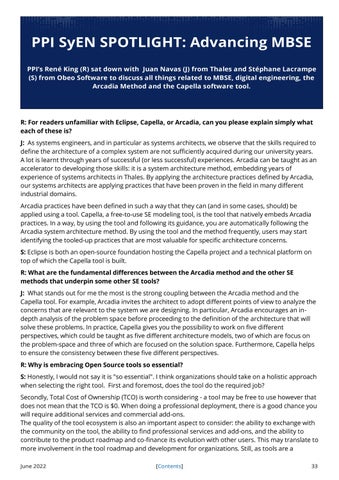PPI SyEN SPOTLIGHT
PPI SyEN SPOTLIGHT: Advancing MBSE PPI’s René King (R) sat down with Juan Navas (J) from Thales and Stéphane Lacrampe (S) from Obeo Software to discuss all things related to MBSE, digital engineering, the Arcadia Method and the Capella software tool.
R: For readers unfamiliar with Eclipse, Capella, or Arcadia, can you please explain simply what each of these is? J: As systems engineers, and in particular as systems architects, we observe that the skills required to define the architecture of a complex system are not sufficiently acquired during our university years. A lot is learnt through years of successful (or less successful) experiences. Arcadia can be taught as an accelerator to developing those skills: it is a system architecture method, embedding years of experience of systems architects in Thales. By applying the architecture practices defined by Arcadia, our systems architects are applying practices that have been proven in the field in many different industrial domains. Arcadia practices have been defined in such a way that they can (and in some cases, should) be applied using a tool. Capella, a free-to-use SE modeling tool, is the tool that natively embeds Arcadia practices. In a way, by using the tool and following its guidance, you are automatically following the Arcadia system architecture method. By using the tool and the method frequently, users may start identifying the tooled-up practices that are most valuable for specific architecture concerns. S: Eclipse is both an open-source foundation hosting the Capella project and a technical platform on top of which the Capella tool is built. R: What are the fundamental differences between the Arcadia method and the other SE methods that underpin some other SE tools? J: What stands out for me the most is the strong coupling between the Arcadia method and the Capella tool. For example, Arcadia invites the architect to adopt different points of view to analyze the concerns that are relevant to the system we are designing. In particular, Arcadia encourages an indepth analysis of the problem space before proceeding to the definition of the architecture that will solve these problems. In practice, Capella gives you the possibility to work on five different perspectives, which could be taught as five different architecture models, two of which are focus on the problem-space and three of which are focused on the solution space. Furthermore, Capella helps to ensure the consistency between these five different perspectives. R: Why is embracing Open Source tools so essential? S: Honestly, I would not say it is "so essential". I think organizations should take on a holistic approach when selecting the right tool. First and foremost, does the tool do the required job? Secondly, Total Cost of Ownership (TCO) is worth considering - a tool may be free to use however that does not mean that the TCO is $0. When doing a professional deployment, there is a good chance you will require additional services and commercial add-ons. The quality of the tool ecosystem is also an important aspect to consider: the ability to exchange with the community on the tool, the ability to find professional services and add-ons, and the ability to contribute to the product roadmap and co-finance its evolution with other users. This may translate to more involvement in the tool roadmap and development for organizations. Still, as tools are a June 2022
[Contents]
33
